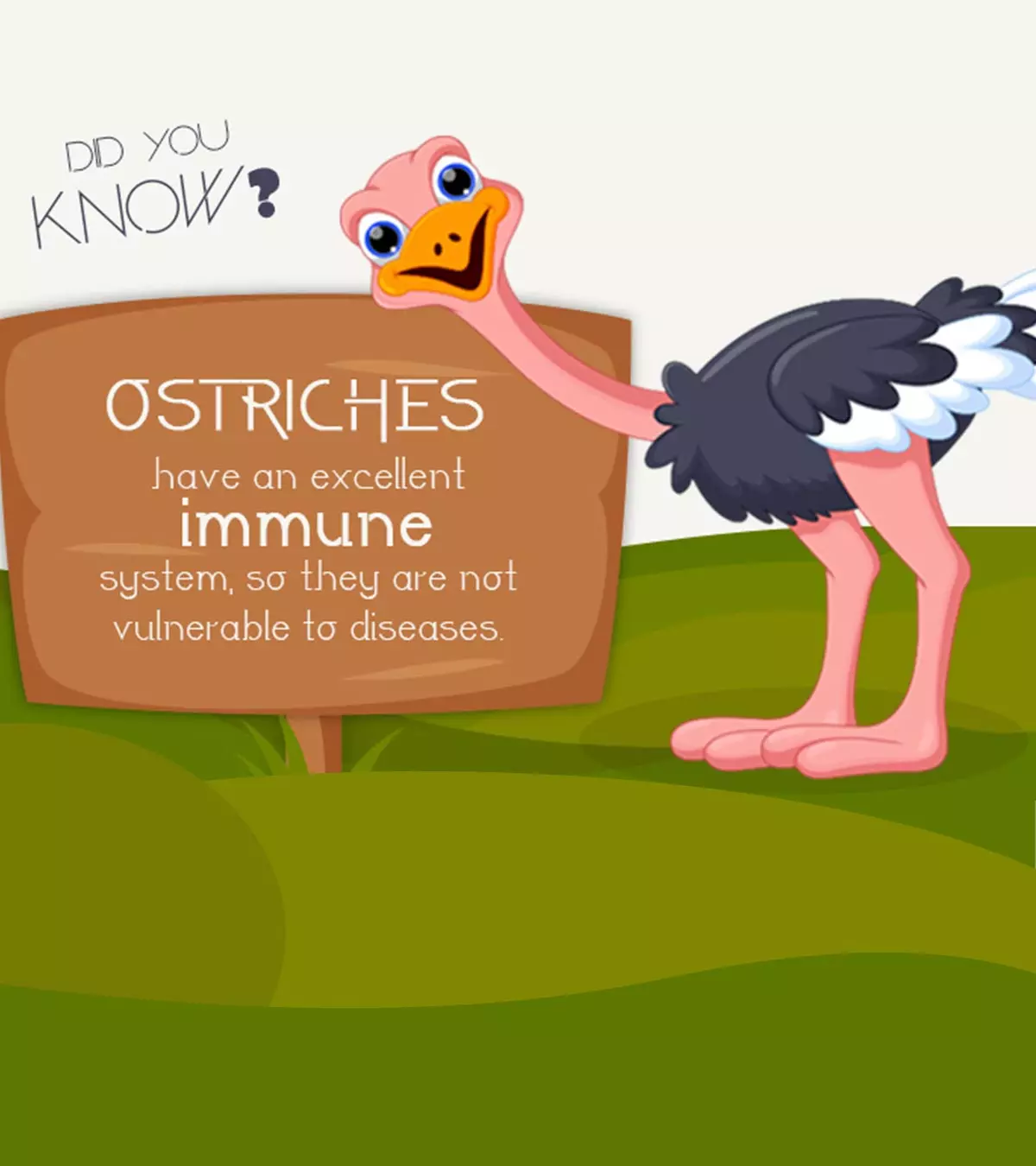

Image: ShutterStock
Most children are mesmerized by the sight of a tall, slender ostrich. If your child is enthralled by the ostrich’s high-speed running, introduce some exciting facts about ostrich for kids that can pique their curiosity.

What Do Ostriches Eat? What do they look like? To answer all these questions, keep reading and share some fascinating facts about the ostrich that your child may be interested in.
Interesting Ostrich Information For Kids
1. What Is An Ostrich?
Ostrich, scientifically well-known as Struthio camelus, is the largest and heaviest living bird on the earth. It belongs to Struthio genus of ratite family of flightless birds, native to Africa, and is the only extant of genus Struthio. Ostriches have existed for past 70 to 120 million years. Until 2014, the ‘common ostrich’ was the only known species of the bird but in 2014 people began considering Somali ostrich as a different species. You can find about two million ostriches worldwide (1).
2. Where Do Ostriches Live?
Ostrich is famous as a xeric bird as it can survive in hot and dry climatic conditions. Even though it is native to Africa, you can find it in many countries worldwide:
- Initially, ostriches used to inhabit in north and south Sahara, Asia Minor, Arabian Peninsula, south of rainforest belt in Africa, and East Africa. But now they prefer to live in Sahel and savannas of Africa in the open environment.
- You can also find this large bird even in the semi-desert area of Africa and farmed birds in New Mexico, Dahlak Archipelago Island in Red Sea, Israel, and Australia (2).
3. What Do Ostriches Eat?
Ostriches are omnivorous birds, so they eat both plant as well as animal food.
- Ostriches eat leaves, roots, and seeds and other plant-based food.
- They eat locusts, insects, rodents, snakes, and lizards.
- Ostrich often swallows pebbles and sand that aid them in grinding up their ingested food in its gizzard, a peculiar muscular stomach. The unique ability to grind the food enables this huge bird to eat several things that other animals cannot digest.
- This bird doesn’t drink water often as it obtains an adequate amount of water from the plants it consumes. It can survive without water for long spans of time. However, if an ostrich comes across a water-filled hole, then it drinks (3).
4. How Do Ostriches Look Like?
Ostrich has unique body features that differentiate it from the rest of the birds. Here, we list some unique features of the bird.
- Height And Weight: An average adult ostrich stands up to nine feet and weighs between 150 to 330 pounds. Male ostrich is about six to nine feet tall at maturity while a female bird is about 5.5 to 6.5 feet. Ostrich chicks tend to grow ten inches long every month in the first year and weigh 100 pounds by the time they complete a year. Normal body temperature of the bird is between 103 and 104 F.
- Color: Male, female, and baby ostriches possess varying colors. Male birds are black and white in color while females are grayish and dull brownish in color. Females have lead-blue skin color which turns scarlet on the forehead, beak, and around the eyes during the mating period.
- Eyes: Ostrich has the biggest eyes in the entire animal kingdom. Its large, protruding eye is 50mm or two inches in diameter and larger in size than its brain. The eye has long lashes for protecting it. Head and bill are comparatively smaller than the eyes.
- Wings: Even though ostriches are flightless birds, their wings are tremendously powerful. They use their wings during their courtship rituals. In the summer and hot periods, they fan their wings to cool themselves, and in the cold months, they enclose their thighs with their wings.
- Legs: Ostriches possess two extremely strong legs. Just one kick from the bird is enough to kill a lion or tiger. Unlike the other birds of the ratite family, who have three toes on foot, the ostrich has two toes on each foot (4).
5. How Fast Does An Ostrich Run?
Ostriches are known to be fast running birds, and its immediate instinct, when they fear, is to run. An average ostrich can cover 16 to 23 feet in one stride, and it runs at a high speed of 30 to 50 miles per hour or 70km per hour continuously for about 30 minutes.
6. Why An Ostrich Cannot Fly:
Since ostriches do not possess a keeled sternum i.e. a breastbone, which is common in most flying birds, they lack the ability to fly (5).
7. Does An Ostrich Bury Its Head In Sand?
No, ostrich doesn’t bury or stick its head or neck in the sand; it’s a myth. It is the defensive behavior of the bird to lay down on the ground when it senses trouble and press its long neck to the earth to become less visible. The plumage of the ostrich blends well with the color of soil or sand and appears as if the bird has buried its head in it.
8. Behavior Of The Ostrich:
Ostriches live together in groups of ten. A group of ten ostriches is famous as a flock. Dominant male ostrich and female bird lead the congregation. Dominant male ostrich bears the responsibility to defend the territory, and his warning sound is quite in-depth and loud, similar to the roar of a lion. At times, ostriches hiss to convey disapproval.
Most often, you can find groups of ostriches grazing along with zebras, gnus, giraffe, and antelopes. Acute eyesight and hearing sensation of the bird enables it to sense predators from far away. So, the company of ostriches is beneficial to other animals and birds as they alert them when they sense any danger.
9. Breeding Habits Of Ostriches:
Usually, ostrich’s breeding season is from March to September. People call male ostrich rooster or cock and female hen, and they follow a peculiar breeding ritual:
- To attract female ostrich, the male bird performs a unique courtship dance by flapping its wings outwards and shaking tail feathers displaying its plumage as it bows.
- When it’s ready to mate, shins, beak, and neck of the male bird turn bright red.
- The impressed female ostrich also changes its color and its feathers turn silver in color.
- The male bird scratches out a shallow hole in the earth and creates a nest while the dominant female lays about seven to ten eggs in the center and other females lay eggs around the center. You can call a communal ostrich nest as dump nest, and it comprises about 60 eggs.
- Both female and male ostriches take turns to incubate the eggs, which hatch in 42 to 45 days.
- A female ostrich can identify its egg even if you mix it with the other eggs.
10. How Large Are The Eggs Of Ostriches?
Eggs of an ostrich are the largest of all the birds. One egg of ostrich is six inches long and weighs three pounds i.e. as much as two dozens of chicken eggs. It takes about two long hours to boil a single egg of the bird (6).
11. How Do Offspring Of Ostrich Look Like?
Offspring of an ostrich is larger than that of any other bird. Both female and male birds look after their young one. When predator attacks, male ostrich tries to get the predator away from its chicks, which run for protection with their mother. By the time the baby completes six months, it grows tall enough resembling a matured ostrich in height and becomes an adult when it is three or four years old. Female ostrich becomes adult six months earlier than males. Farmed ostrich matures earlier than a wild ostrich i.e. within two or three years.
12. What Attracts Ostriches?
Small shiny objects attract ostriches. You may find these birds pecking at unknown small, shiny items on the ground out of curiosity.
13. What Is The Lifespan Of An Ostrich?
An ostrich can live from 50 to 75 years. Domesticated birds live 50 years and above in captivity while wild ostriches live for 20 to 30 years.
14. Who Are The Predators Of Ostrich?
Since Ostriches are native to Africa, they have to watch out for the prominent African predators. Leopards and lions are major predators. Also, African hunting dogs, spotted hyenas and cheetahs eat ostriches. Vulture, jackal, and mongoose eat the eggs of the bird. However, all predators need to watch out when hunting for ostrich as just its kick can cost them their life.
15. What Is Ancient Egypt Belief About Ostrich Feather?
Ancient Egyptians believed in the use of ostrich feather. Egyptians believed that the God uses the feather of ostrich on one side of the scale with the heart of a dead person on the other. If the ostrich’s feather weighed greater than the heart, then it meant that the person led a good life, and he would enter the afterlife. If the feather weighed lesser than the heart then the Ammit, a female Egyptian demon having the head of a crocodile and body of a lion, would eat the soul of the dead person.
16. Can Ostriches See In Dark Or At Night?
Ostriches are diurnal birds, which are quite active in the moonlight nights. They have acute eyesight that helps them stay alert even in the dark.
17. What Is Ostrich Farming?
Individuals practice ostrich farming in countries having cold climates such as Alaska and equatorial climates like central Africa. Today, people practice ostrich farming successfully in at least 50 nations.
18. How Beneficial Is Ostrich To Humans?
Ostrich farming is free range open farming alternative available anywhere worldwide with a number of benefits that include:
- Meat: Ostrich farming offers high nutritional value meat that also has high commercial value. The meat has a fine texture, similar to the color of beef, and is low in sodium, calories, cholesterol, and fats. Also, it is a rich source of proteins and iron.
- Egg Shells: Egg shells of ostrich are suitable to carve ornaments, decorative jewelry, and used as a container. A farmer can use young ostrich stock for resale or sell the eggs for hatching.
- Feathers: Feathers of ostrich are of high quality and have a high demand in the fashion industry.
- Leather: People prefer ostrich’s beautiful leather to create handbags and polka dot patterned fashion goods.
19. What Is The Conservation Status Of Ostriches?
According to the International Union for Conservation of Nature, most ostriches are not endangered species even though their population is reducing. The Somali ostrich is the vulnerable species as surveys and research reveal its rapid reduction.
20. What Can You Do Towards Conservation Of Ostrich?
If you would like to promote ostrich conservation, you can work to promote wildlife tourism in Africa, as it would help preserve land creating job opportunities for local communities. Also, you can make donations to reputed organizations that support eco-tourism in Africa and other ostrich dominant areas.
10 Fun Ostrich Facts For Kids
- In Ancient Egypt, people used ostriches to pull chariots.
- In some African nations, people race by sitting on the back of ostriches with specialized saddles, bits, and reins.
- Fossils and skeletons of ostriches date back to over 120 million years which indicate the presence of ostriches in the dinosaurs’ era.
- Ostriches have an excellent immune system, so they are not vulnerable to diseases.
- The brain of an ostrich is as tiny as a walnut.
- To hard boil an ostrich egg, it takes approximately 1.5 hours and soft boil takes about one hour.
- An ostrich possesses a four-inch long claw in each foot.
- An adult ostrich carries about one kg of stones in its stomach.
- Ostriches have about 50 to 60 tail feathers.
- Medical researchers reveal that the cornea of an ostrich’s eye can replace the human’s cornea.
Did you tell tiny tot any of the above interesting facts about ostrich? Which fun facts and information did he find incredible? Share your unique experience and knowledge with the fellow moms by leaving a comment below.
Frequently Asked Questions
1. Do ostriches have teeth?
Ostriches don’t have teeth, so they can’t chew their food. They swallow stones and pebbles that help them to digest their food (7).
2. Why do ostriches have three stomachs?
Ostriches have three stomachs for two reasons. Firstly, they lack the teeth to chew their food, so their food is entirely digested in the stomach. Their stomach that grinds the food is called a gizzard. Secondly, ostriches eat a large amount of plant material with pebbles and stones, which are hard to digest. The stomach that releases the chemicals to digest food into small macromolecules is called the “true” stomach.
Learning interesting facts about ostrich for kids is a boon as their curiosity increases as they encounter new things and learn more. Hence, we curated the list to keep their interest in the right place and give them all the information regarding this magnificent creature. So go ahead and read aloud some exciting facts to your kids and discuss them in detail. Allow them to come up with more questions to ensure that their inquisitiveness has been satisfied by the end of the list.
References
- Trove Newspapers and Gazettes.
http://trove.nla.gov.au/newspaper/ - 6th National Report to the Convention on Biological Diversity.
https://www.cbd.int/doc/nr/nr-06/er-nr-06-en.pdf - Ostrich.
https://animals.sandiegozoo.org/animals/ostrich - Ostrich.
https://netvet.wustl.edu/species/birds/ostrich.txt - Why don’t Ostriches fly?
http://faculty.washington.edu/beccap/workspace/uploads/pdf/Why-dont-ostriches-fly.pdf - The Ostrich (Struthio camelus) Egg – a Safety Seat in the Time Vehicle.
https://journals.tubitak.gov.tr/veterinary/issues/vet-09-33-1/vet-33-1-12-0802-13.pdf - Ostrich.
https://www.marylandzoo.org/animal/ostrich/
Community Experiences
Join the conversation and become a part of our nurturing community! Share your stories, experiences, and insights to connect with fellow parents.
Read full bio of Manjiri Kochrekar















